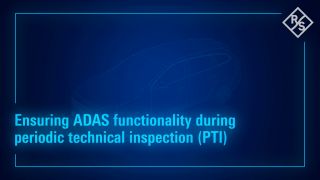ADAS periodic technical inspection
Radar target simulator for ADAS testing in PTI environment
Ensuring the continued functionality of advanced driver assistance systems (ADAS) and autonomous driving (AD) features is paramount for long-term vehicle safety and performance. As such, manufacturers of autonomous vehicles require approval from transportation authorities. Before a vehicle leaves the factory, an end-of-line (EOL) test checks all functions for proper operation. However, maintaining proper ADAS/AD functionality over years of use requires additional measures.
A safe, straightforward approach is to extend the regular periodical technical inspection (PTI) to include checks of AD functions and involved sensors. The PTI process comprises four key steps:
- Visual inspection: Checking the vehicle, brakes and external components such as sensors, bumpers or radomes for signs of damage.
- Software check: Verifying that the vehicle’s software recognizes data in accordance with regulatory standards and homologation requirements.
- Static test: Simulating artificial radar signals and validating sensor responses in a controlled, static environment.
- Effectiveness test: Assessing the complete functionality of ADAS features such as autonomous emergency braking (AEB) and adaptive cruise control (ACC) to ensure proper operation.
While visual inspection and software checks suffice for many vehicles today, the dynamic nature of ADAS necessitates comprehensive static and effectiveness testing to guarantee safe operation throughout a vehicle’s lifespan. By incorporating these additional layers into the PTI process, it is possible to ensure the integrity and performance of ADAS technologies over the long term.







